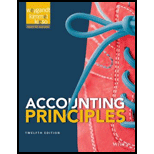
Concept explainers
(a)
Break-Even Point: The break-even point is a point where the total cost incurred is same as the total revenue earned. At the break-even point, the profit will be zero. The break-even point is the point in the business where there is no loss and no gain.
Margin of Safety Ratio: The margin of safety is the difference between the actual value of the sales and the break-even sales value. When this amount is compared with the expected value of sales and the value expressed in percentage is the margin of safety ratio.
Cost-Volume-Profit (CVP) Income Statement: The cost-volume-profit income statement refers to that income statement which highlights the cost behavior as a variable cost and fixed costs. It also shows the contribution margin of the company. This statement is for the internal use in the company. The format of this statement depends upon the need of the business.
To determine: The current break-even point and the break-even point if the given idea is used.
(b)
The margin of safety ratio for current operations and after the changes.
(c)
To prepare: A CVP income statement for the current operations and for after the changes.
Trending nowThis is a popular solution!

Chapter 22 Solutions
Accounting Principles - Standalone book
- I need help solving this general accounting question with the proper methodology.arrow_forwardI am searching for the accurate solution to this general accounting problem with the right approach.arrow_forwardI am looking for help with this general accounting question using proper accounting standards.arrow_forward
- Can you help me solve this general accounting problem using the correct accounting process?arrow_forwardPlease provide the correct answer to this general accounting problem using valid calculations.arrow_forwardIn addition to your explanation, address the following self-reflection questions: How does the WH Framework help you analyze the situation? Now that I've put together the framework, how does the WH Framework help managers with making business decisions? And What type of decisions would the WH Framework chart help make as a manager?arrow_forward
- Please provide the accurate answer to this general accounting problem using valid techniques.arrow_forwardPlease provide the answer to this general accounting question using the right approacharrow_forwardCan you demonstrate the accurate method for solving this financial accounting question?arrow_forward
- Can you solve this general accounting problem using appropriate accounting principles?arrow_forwardPlease explain the solution to this general accounting problem with accurate principles.arrow_forwardI am looking for a step-by-step explanation of this financial accounting problem with correct standards.arrow_forward

 AccountingAccountingISBN:9781337272094Author:WARREN, Carl S., Reeve, James M., Duchac, Jonathan E.Publisher:Cengage Learning,
AccountingAccountingISBN:9781337272094Author:WARREN, Carl S., Reeve, James M., Duchac, Jonathan E.Publisher:Cengage Learning, Accounting Information SystemsAccountingISBN:9781337619202Author:Hall, James A.Publisher:Cengage Learning,
Accounting Information SystemsAccountingISBN:9781337619202Author:Hall, James A.Publisher:Cengage Learning, Horngren's Cost Accounting: A Managerial Emphasis...AccountingISBN:9780134475585Author:Srikant M. Datar, Madhav V. RajanPublisher:PEARSON
Horngren's Cost Accounting: A Managerial Emphasis...AccountingISBN:9780134475585Author:Srikant M. Datar, Madhav V. RajanPublisher:PEARSON Intermediate AccountingAccountingISBN:9781259722660Author:J. David Spiceland, Mark W. Nelson, Wayne M ThomasPublisher:McGraw-Hill Education
Intermediate AccountingAccountingISBN:9781259722660Author:J. David Spiceland, Mark W. Nelson, Wayne M ThomasPublisher:McGraw-Hill Education Financial and Managerial AccountingAccountingISBN:9781259726705Author:John J Wild, Ken W. Shaw, Barbara Chiappetta Fundamental Accounting PrinciplesPublisher:McGraw-Hill Education
Financial and Managerial AccountingAccountingISBN:9781259726705Author:John J Wild, Ken W. Shaw, Barbara Chiappetta Fundamental Accounting PrinciplesPublisher:McGraw-Hill Education





